Last-Minute NYC Holiday Gift Guide 🎁
We’ve created a holiday gift guide with presents for the intrepid New Yorker that should arrive just in time—


As a new “Sydneysider,” I tend to stay away from the outspoken Sydney-Melbourne rivalry, which dates back to Pre-Federation Australia. The truth is I struggled tremendously when moving to Australia trying to decide which city to live in. From an outsider’s perspective, I would say that both Sydney and Melbourne have appeal for their diverse and unique qualities (how “PC” of me).
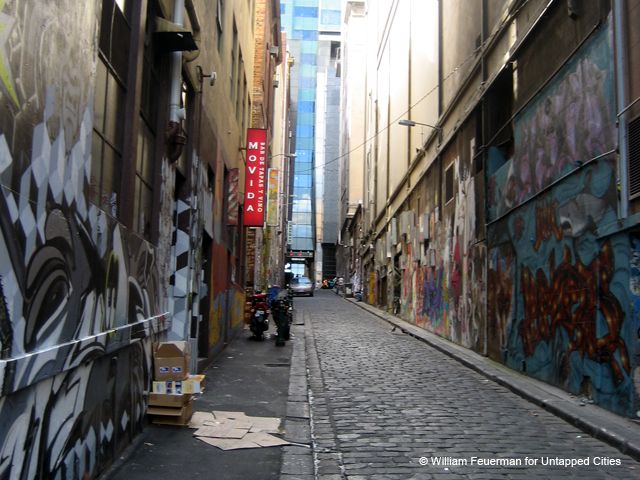
Melbourne Laneway
I love Melbourne. There is a certain energy and creativity in Melbourne, coupled with a grittiness which at times resembles New York. One of its most distinct qualities is its meandering streets and laneways that make up the city center. Exploring the city’s hive of laneways, bustling with activity and creativity, you find some of the best of Melbourne. Everything is understated or hidden; as you wander down narrow pedestrian scaled alleyways covered in graffiti.
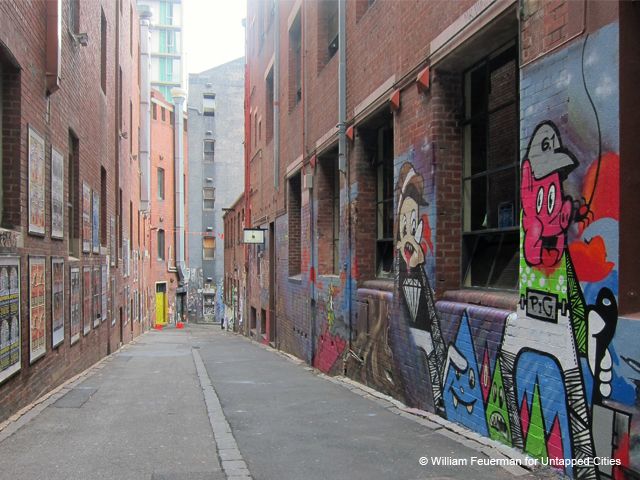 Melbourne Laneway
Melbourne Laneway
You’ll stumble across small bars, hole-in-the-wall cafes, massage parlors, high end restaurants, galleries, boutique stores and, of course, the “hipster-dufus-trendy” establishment. It’s a unique urban condition-unfamiliar to someone raised in Los Angeles, where a typical street is the equivalent scale to an Australian highway and the closest thing to a laneway is a desolate alley, where the backs of buildings are revealed, garbage is stored and collected, and parking accessed. The Melbourne laneway has this but so much more. It is distinctive with a truly individual identity. These laneways are not quite a London mews, not quite a Paris arcade, but a sort of city-within-a-city that provides an inner layer of urban experience.
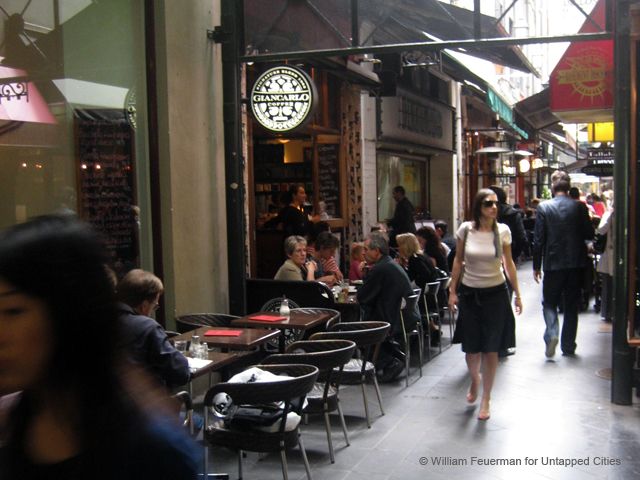 Melbourne Laneway
Melbourne Laneway
It took some time living in Sydney to realize that Sydney has its own version of the laneway. The laneway was once a common condition within the city, a component of the urban geography. An 1854 map of Sydney reveals a complex matrix of small scaled lanes, arcades, passageways and courtyards, juxtaposed against the major streets of the Central Business District (CBD). By 1980, 126 years later, most of these spaces had been slowly erased, to maximize building area.
Today, the City of Sydney is working to emulate the success of Melbourne’s laneways, while hopefully retaining their own “Sydney” identity, by working to revitalize many of the unused or forgotten lanes throughout the city. The initiative, which is a component of the Sustainable Sydney 2030 plan, includes street improvements, permanent and temporary art installations and business incentives including mentoring for small businesses (cafes, bars, retail boutiques, galleries, etc). While this has come with its own baggage-whining residents complaining about disrespectful patrons, high permit costs and liquor freezes, the City of Sydney is working hard to resurge and re-activate these spaces.
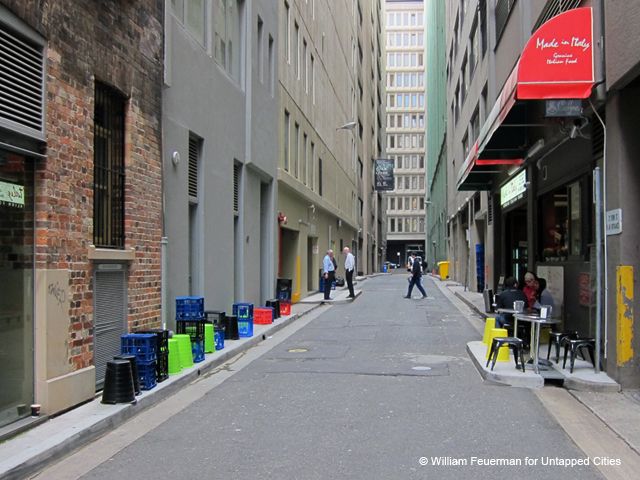 Sydney Central Business District (CBD) Laneway
Sydney Central Business District (CBD) Laneway
The current Sydney laneway ranges in character depending on its location. Some are incredibly charming, lined with traditional sandstone residences. Others are bleak, appearing more as a service corridor with hidden pockets of activities and some of the best bars in Sydney. And then there are the true wonders that you happen upon. Take, for example, McElhone Place in Surry Hills, a laneway that was transformed into an urban garden, an outdoor oasis for the residents and by the residents (founded by Olive Batty), covered in plant life, colorful flowers, garden sculptures, ornate benches randomly dispersed, and a cat that keeps guard. While these spaces tend to feel somewhat alienated, operating mostly as a network of shortcuts, they produce a series of discontinuous events and environments scattered throughout the city.
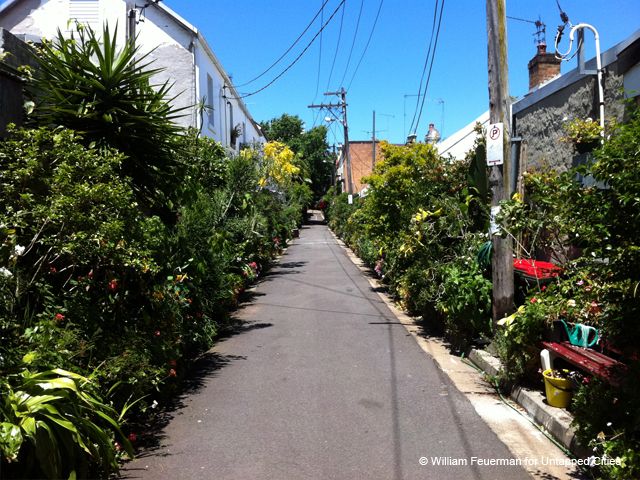 McElhone Place, Surry Hills, Sydney
McElhone Place, Surry Hills, Sydney
As a way to raise awareness of these underutilized spaces, the city is currently curating a Laneway Art Program, as part of Sydney’s Art & About Festival. Until January 31, 2012, a series of laneways scattered throughout the CBD will be transformed by temporary art installations. Download the app, which has its own tour and map (you can also print it out and carry a hard copy, if you prefer), and get lost in some of the city’s remaining laneways.
My favorite piece, Peri(pheral)scopes by Heidi Axelsen, Hugo Moline and Adriano Pupilli is installed on Skittle Lane, a non- descript, dead end, vehicular access way. A series of yellow periscopes grow out of the laneway’s infrastructure and offers the passer-by a view into another world. As the artists describe the piece, “the views presented are glimpses of places as only locals know them, looking-over to the over-looked.” There is a strangeness to these bright yellow objects that squirm and wrap around the pipes, shafts and brickwork of the lane.
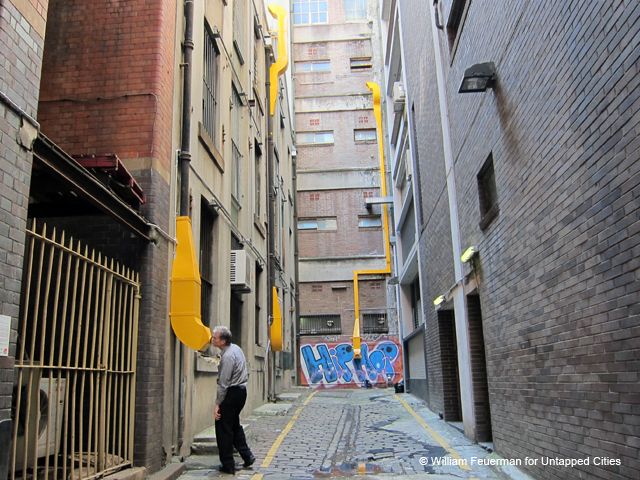 Peri(pheral)scopes by Heidi Axelsen, Hugo Moline and Adriano Pupilli, Skittle Lane, Sydney
Peri(pheral)scopes by Heidi Axelsen, Hugo Moline and Adriano Pupilli, Skittle Lane, Sydney
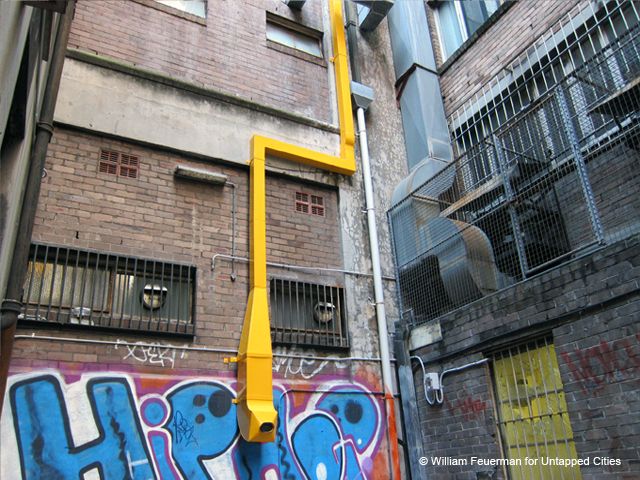 Peri(pheral)scopes by Heidi Axelsen, Hugo Moline and Adriano Pupilli, Skittle Lane, Sydney
Peri(pheral)scopes by Heidi Axelsen, Hugo Moline and Adriano Pupilli, Skittle Lane, Sydney
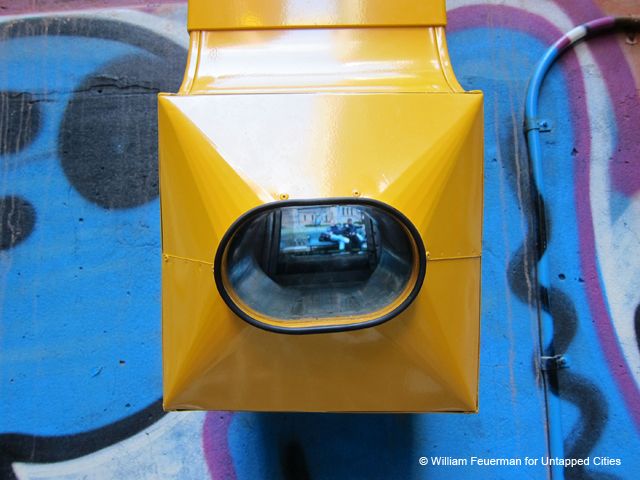 Peri(pheral)scopes by Heidi Axelsen, Hugo Moline and Adriano Pupilli, Skittle Lane, Sydney
Peri(pheral)scopes by Heidi Axelsen, Hugo Moline and Adriano Pupilli, Skittle Lane, Sydney
Just a couple of blocks away, another favorite (although I do wish it was better constructed) is Isidro Blasco’s Deconstructing Ways. A perspectival image of a laneway is superimposed at an intersection of two perpendicular lanes, creating a billboard image of a third lane. The project sits incredibly understated, only noticed by those that are aware of their surroundings. Once I took out my camera to capture the installation, people stopped and examined. It became an instant event!
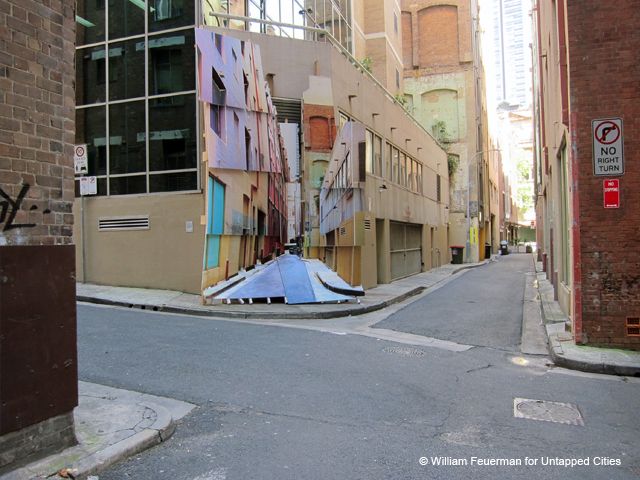 Deconstructing Ways by Isidro Blasco, Mullins Street & Market Row, Sydney
Deconstructing Ways by Isidro Blasco, Mullins Street & Market Row, Sydney
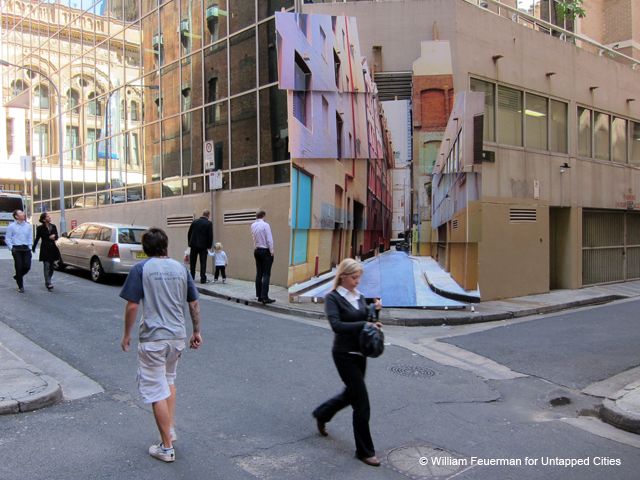 Deconstructing Ways by Isidro Blasco, Mullins Street & Market Row, Sydney
Deconstructing Ways by Isidro Blasco, Mullins Street & Market Row, Sydney
Other installations include Brook Andrew’s Donut, an inflatable donut-shaped object that floats above passerby’s heads; Bubbleway, by Rebar, an inflatable modular furniture system which produces both a place to relax in the hot Sydney sun and an urban playground (with great bounce); and Magda Sayeg’s Guerrilla Knitting, a knitted textile of color swatches attached to the risers of a concrete and steel stair.
 Donut by Brook Andrew, Bridge Lane, Sydney
Donut by Brook Andrew, Bridge Lane, Sydney
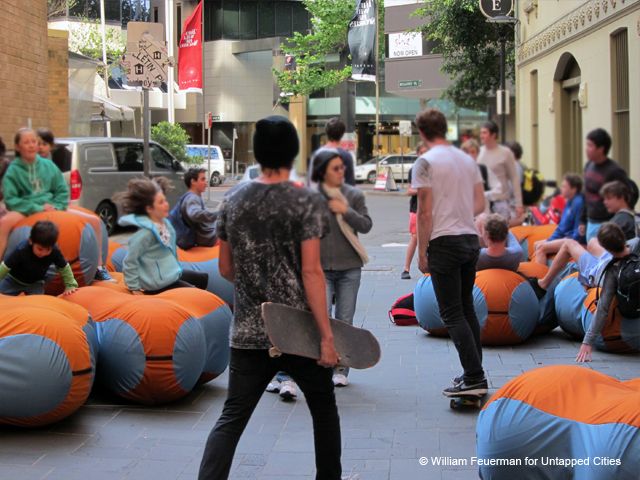 Bubbleway by Rebar, Bulletin Place, Sydney
Bubbleway by Rebar, Bulletin Place, Sydney
 Untitled, Magda Sayeg, Sussex Lane, Sydney
Untitled, Magda Sayeg, Sussex Lane, Sydney
The Art & About Festival introduces Sydneysiders to the myriad laneways across the city. It also introduces new, more permanent attractions slowly being integrated into many laneways, from bars, cafés and boutiques to installations such as Angel Place, a laneway currently being transformed by 120 floating birdcages, cobblestones and outdoor dining.
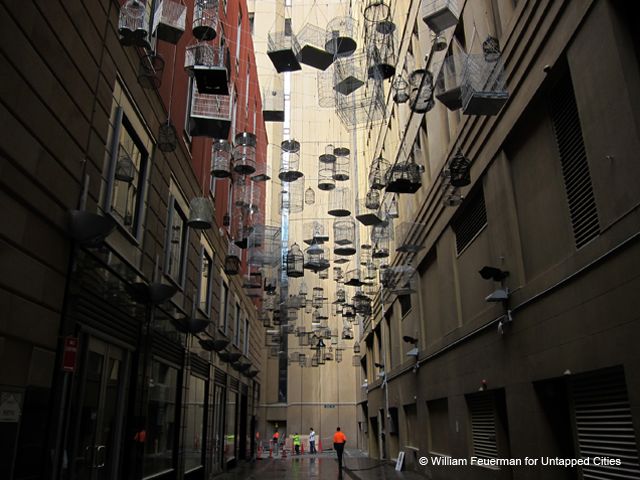 Angel Place, Sydney
Angel Place, Sydney
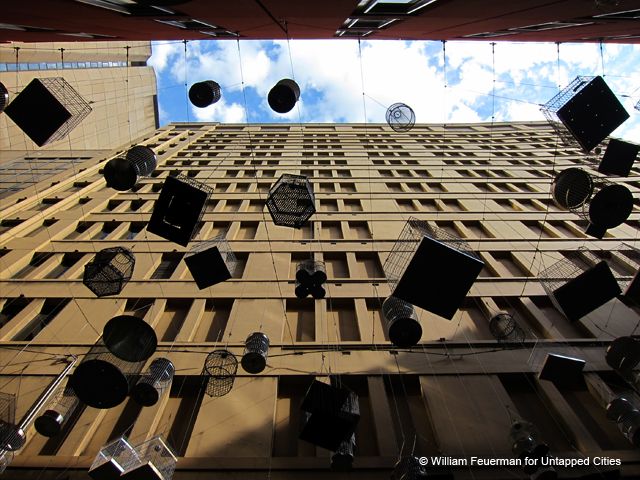 Angel Place, Sydney
Angel Place, Sydney
The City of Sydney’s motto is “a city of villages” and the laneways help define the village-like scale of Sydney, fusing neighborhoods while creating active urban spaces. Only time will tell whether or not Sydney’s investment in revitalizing its laneways will pay off. It may take a while to reach the success of Melbourne’s lane network but Sydney must embrace its own opportunities, creating an individualized space to explore and enjoy.
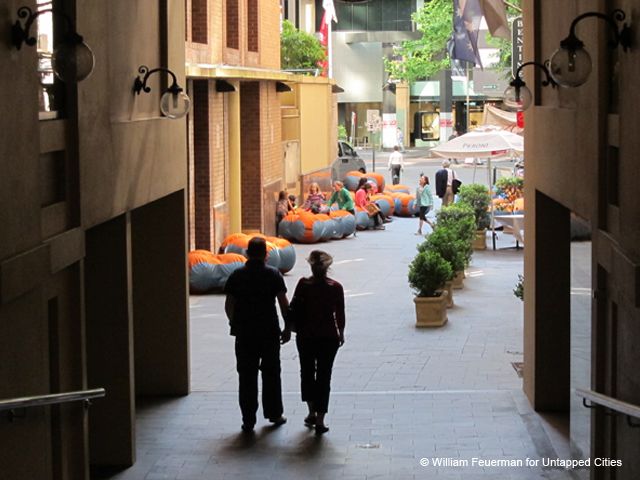 Bulletin Place, Sydney
Bulletin Place, Sydney
Subscribe to our newsletter